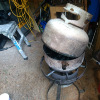WestKentucky
Member
I have considered casting for a while, and the decision was finally made. Today I dropped by the local Goodwill and picked up some cast-off kitchen gizmos to start the process. I made some small purchases so the journey has officially started.
Mini muffin tin (aka ingot mold) $2
Dutch oven with neat splash resistant lid (aka bulk dirty melting pot) $6
Riser doohickey to get heat underneath the Dutch oven $6
$14 well spent as far as I’m concerned. I need lead, and a dipper to make ingots. I need a production pot and bullet molds to make bullets. It’s a good start.

Mini muffin tin (aka ingot mold) $2
Dutch oven with neat splash resistant lid (aka bulk dirty melting pot) $6
Riser doohickey to get heat underneath the Dutch oven $6
$14 well spent as far as I’m concerned. I need lead, and a dipper to make ingots. I need a production pot and bullet molds to make bullets. It’s a good start.






